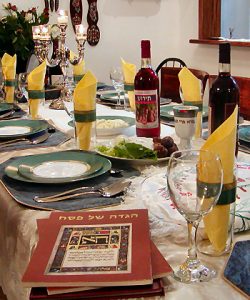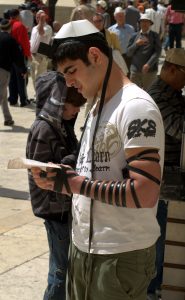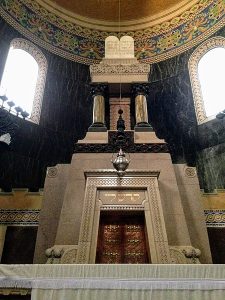48 Ritual and Experience in Judaism
Experiencing the Torah: Holy Days
Today, many of the rituals in Judaism are symbolic reenactments of events in Israelite history. These include: observing the Sabbath, which commemorates the break that God took after creation; the celebration of Passover, which commemorates the events associated with the Israelites being rescued from Egyptian bondage; Rosh Hashanah, which celebrates the Jewish New Year; and Yom Kippur, known as “the day of atonement,” where Jews ask God for forgiveness for their transgressions.

There are also many important rituals associated with life cycles in Judaism. These include the rituals of circumcision for males; the bat- and bar-mitzvah celebrations that represent becoming recognized as adults by the Jewish community; the practice of taking purifying baths known as Mikvah; and marriage and death rites. There are also rituals for following proper dietary restrictions that are laid out in the Torah. Foods that are ritually pure are known as kosher foods.
Coming of Age: Bar mitzvah and Bat mitzvah
The event of the bar mitzvah is a ritual of initiation into adulthood that takes place when a young boy reaches the age of thirteen and a girl becomes twelve. For young men, this ceremony is known as bar mitzvah; for young women, it is known as bat mitzvah. After the ceremony, the young man or woman is regarded as an adult by the Jewish community. Being considered an adult comes with certain religious privileges and responsibilities.
On the day of the bar mitzvah the Jewish community gathers in the synagogue. In a Bar mitzvah the young man wears a tefillin which It has two parts: a box and prayer strap which is wrapped around the arm, and a small box worn on the head. The tefillin boxes contain four passages from the scriptures that emphasize the duty of humans to the one God and the promise God has made to them. These sacred objects remind the wearer that following the Torah requires both the heart (the strap on the arm) and the mind (the box on the head).

In the Bar mitzvah or Bat mitzvah ritual the young person reads aloud from the Torah in Hebrew in front of the community. He gives a short speech interpreting the passage in the Torah. After the ceremony, there is typically a celebration consisting of food and dancing. Guests give the young person gifts such as religious literature or money. From this point forward, he or she is seen as responsible for their own actions and for fulfilling the commandments of the Torah.

Social Organization in Judaism
The synagogue is the center of Jewish life and social organization. There are various denominations in contemporary Judaism. The Orthodox branch of Judaism emphasizes following the law of the Torah and other commentaries that prescribe rules for diet, family life, and frequent worship at the synagogue under the direction of male rabbi. Reform Judaism emphasizes the spirit of the law and ethical principles, rather than strictly following the rules. They suggest accommodations to the contemporary society and allow women to become rabbi. Conservative Jewish groups are in a middle ground between Orthodox and Reform Jews, emphasizing the orthodox rules, but allowing some accommodation to modern life. These are the three major groups of Jewish identity, but there are other approaches as well, including “secular” Jews which considers Jewish identity to be a matter of culture and ethnicity, not particularly religious.
The synagogue functions both as a center of religious worship as well as community life for Jews. The activities at a synagogue may include classes and social gatherings. Because kosher dietary laws have certain requirements about the slaughtering of animals and the preparations of materials for food, the Jewish community also supports specific businesses that can provide kosher foods.
The board of a synagogue hires a rabbi who leads the services. A rabbi is a teacher, one who knows the Torah and commentaries well and can advise others. A rabbi is not a priest as in Christian groups. He or she is considered to be an authority on the teachings. The board also hires a cantor who chants scripture at the service. Although the rabbi can do this as well, a cantor who specializes in the songs and chants is considered to be a real asset to the aesthetics of the services. There must be a minimum number ten people for prayer services. This is called the minyan. The idea is that although one can pray alone, praying in a group has great benefits.
Material Culture: The Synagogue
We learned about the significance of the The Temple in Jewish history: it was not merely a place of worship, but represented the independent worship of the Hebrew faith and the place where they conducted the important sacrifices to YHWH. In modern Judaism there are various terms for a place of worship, but the most common one is synagogue, a house of prayer. The synagogue also acts as a kind of community center with a library for study and study groups as well as classes for young people preparing for bar mitzvah and bat mitzvah. The congregation employs a rabbi who guides the community services and a cantor who performs the chants. These two employees are hired and by lay members of the board of the synagogue.
The synagogue building is laid out with particular rules. The front of the sanctuary where prayers are conducted faces towards Jerusalem. The sanctuary contains a special cabinet called the Ark which contains the scrolls of the Torah. It is at the front of the sanctuary, so that participants are both facing Jerusalem and the Ark during the services. Near the Ark is a lamp, called the “eternal lamp” which is meant to follow the command to keep a light burning near the Ark where the Torah is kept (Exodus 27: 20-21).

In this image of the Ark of the Covenant at Trieste you can see the structure of the cabinet that holds the Torah with a lamp just above the two main doors of the ark.
The synagogue also contains memorial plaques for deceased members of the congregation, either in the sanctuary itself or right outside it. Each memorial plaque gives the name of the person and their birth and death dates. Small electric bulbs flank the memorial tablets. Usually, these are not turned on, but the bulbs are lit to commemorate the anniversary of day the person died. In this way, the deceased continue their relationship with the synagogue and its community.
